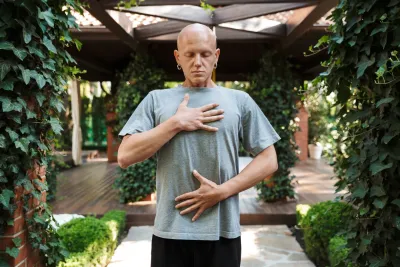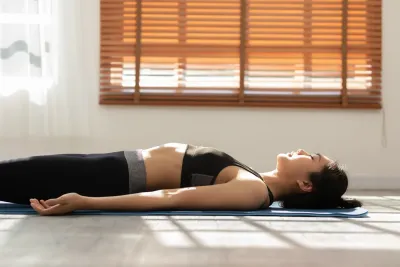Box Breathing Exercise: The Benefits & How to Get Started
Ana Marie Schick: Resident Sleep Expert & Certified Health Coach • Mar 03, 2023

Key Takeaways
- Breath Control: Box breathing is a four-part technique (inhale, hold, exhale, hold) that balances your nervous system and calms your mind.
- Sleep Support: Practicing box breathing before bed can slow your heart rate and signal your body it’s time to rest.
- Stress Reset: It’s a simple, science-backed way to reduce anxiety, lower cortisol levels, and boost focus.
- Easy Routine: Just 5 minutes a day can help improve your sleep quality and mental clarity.
- Pair It: Combine with a cool, dark sleep environment to maximize the calming effects.
Suffering from anxiety or feeling overwhelmed might make it hard to take the advice of "just breathe." Box breathing, a simple breathing exercise, is gaining popularity and can be useful for calming down, being mindful, and managing stress.
The good news is, anyone can participate in this exercise! You don’t have to be an experienced Zen or yoga master or a NAVY Seal to incorporate box breathing into your everyday routine.
Managing Your Breathing: Research indicates that managing your breathing can reduce the amount of cortisol, the stress hormone, in your body, and potentially even support a decrease in heart rate and blood pressure. [1]
Below, we’ll help you understand more about this popular deep breathing exercise, its health benefits, and how to practice box breathing.
What is Box Breathing?
Box breathing, also known as square breathing or four-square breathing, is a yoga deep breathing exercise commonly used to help slow down your breathing and relieve stress.
Box breathing helps distract your thoughts as you slowly count to four for a total of four times. The individual inhales, holds the breath, exhales, and holds the breath again for specific lengths of time, typically held at the same time, usually four seconds each. Counting and focusing on your breath can calm your nervous system and decrease your body's stress level.
Read Study: How Breath-Control Can Change Your Life. [2]
Other names for this breathing technique include:
- Square breathing
- Equal breathing
- 4x4 breathing
- 4-4-4-4 breathing
- Four-square breathing
Did You Know: Box breathing, which is used to improve concentration and alertness quickly, was first made popular by the Navy SEALs. [3]
Benefits of Box Breathing
Box Breathing is a simple but powerful and effective relaxing technique that focuses on your breathing. There are plenty of benefits, including;
Improves Sleep Quality:
If you are feeling overwhelmed, this is a great breathing exercise to help calm the mind leading up to bedtime resulting in better sleep. [4] Deep, slow breathing has been shown to produce melatonin, a hormone that plays a role in your sleep. [5]
Reduce Stress and Anxiety:
Slowing down your breathing while focusing on the present moment can help reduce the feeling of being stressed or anxious.
Read More: How to Sleep When Stressed
Daily Focus:
Counting helps you refocus during stressful situations and busy days. It can help you control your current situation.
Lower Blood Pressure & Stress Hormones (Cortisol):
Slowing your breathing and taking deep breaths can help relax the body, lowering blood pressure. When you lower your blood pressure, you also lower your stress hormones (Cortisol). [6]
Enhance Concentration:
Focusing on breathing can help clear your mind and improve concentration.
Improve Athletic Performance:
Box breaths can help athletes control their breathing during high-intensity activities, enhancing their overall performance.
Additionally, deep breathing, in general, has been found to have positive effects on physical and mental health.
Box Breathing Technique
Like any exercise or yoga routine, preparing yourself is essential. Below we’ve listed the steps to perform this breathing exercise properly.
How to Get Started with Box Breathing
- Step 1: Find a quiet space. You'll either want to lie flat on the floor (you can use a yoga mat or sheet) or sit comfortably in a chair with back support. If you're sitting in a chair, make sure that your feet are flat on the floor, with all ten toes firmly planted.
- Step 2: Select a room that's a stress-free and quiet environment. That way, you can focus on your posture and breathing.
- Step 3: Clear your mind by closing your eyes and allowing your mind to be void of all thoughts.
- Step 4: You'll want to close your eyes and breathe slowly through your nose while counting to four.
- Step 5: Hold your breath while counting to four.
- Step 6: Slowly exhale through your mouth for a count of four seconds.
- Step 7: Repeat the breathing steps above for a few minutes. Make sure you focus on breathing and counting for four seconds.
Once familiar with the process, try various inhale, hold, exhale, and hold intervals that work best for you. The emphasis is on the breath and maintaining steady counts throughout.
Note: Like any type of exercise, starting slow is recommended. Respect your body, don't push it if you feel uneasy or faint. Begin with shorter inhalations/exhalations and increase gradually as you become more comfortable and familiar with this way of exercising.
Final Thought
Now you’re ready! Sleepme has an awesome box breathing exercise video to start this journey. We offer a 5-minute box breathing exercise with Jason Campbell. Follow along as he guides you through the box breathing techniques and exercises to slow down your breathing. You can use this exercise anytime you need to relax and re-center.
Regardless of the specific deep breathing techniques, breathing exercises have been shown to aid in relaxation, improve sleep, and promote natural and efficient breathing. With various options available, you'll likely fall asleep quickly if you focus on your breath.
Box Breathing Frequently Asked Questions
How Can Box Breathing Benefit Me?
Practicing box breathing can help reduce stress and anxiety, lower blood pressure, improve concentration, and enhance sleep quality. It's also used by professionals in high-stress environments to maintain calmness.
Tips for Effective Box Breathing Practice
Here are some helpful tips on how to get started and enjoy the benefits of box breathing:
- Find a Quiet Environment:? Choose a peaceful space to minimize distractions.?
- Maintain Good Posture:? Sit upright with your back supported and feet flat on the floor.?
- Be Consistent:? Practice regularly, aiming for at least 5 minutes daily.?
- Adjust the Count if Needed:? If four seconds feels challenging, start with a count of three and gradually increase.?
- Listen to Your Body: If you feel lightheaded or uncomfortable, stop and resume normal breathing.
References
[1] Hopper, S. I., Murray, S. L., Ferrara, L. R., & Singleton, J. K. (2019). Effectiveness of diaphragmatic breathing for reducing physiological and psychological stress in adults: a quantitative systematic review. JBI database of systematic reviews and implementation reports, 17(9), 1855–1876. View Study
[2] Zaccaro, A. (2018, September 7). How Breath-Control Can Change Your Life: A Systematic Review on Psycho-Physiological Correlates of Slow Breathing. View Resource
[3] JPearce, Michelle . “Mindbodygreen.” Mindbodygreen.com, 2024. View Study
[4] Zaccaro, A., Piarulli, A., Laurino, M., Garbella, E., Menicucci, D., Neri, B., & Gemignani, A. (2018). How Breath-Control Can Change Your Life: A Systematic Review on Psycho-Physiological Correlates of Slow Breathing. Frontiers in human neuroscience, 12, 353. View Study [5] Jerath, R., Beveridge, C., & Barnes, V. A. (2019). Self-Regulation of Breathing as an Adjunctive Treatment of Insomnia. Frontiers in psychiatry, 9, 780. View Study [6] Hopper, S. I., Murray, S. L., Ferrara, L. R., & Singleton, J. K. (2019). Effectiveness of diaphragmatic breathing for reducing physiological and psychological stress in adults: a quantitative systematic review. JBI database of systematic reviews and implementation reports, 17(9), 1855–1876. View Study









